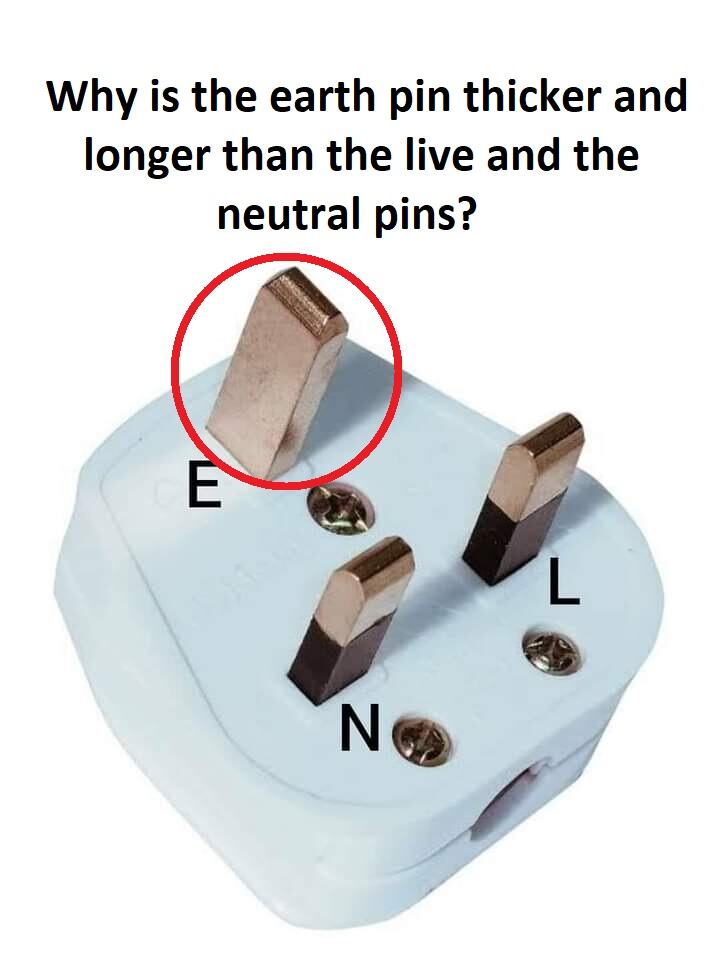Answer:
The earth pin is thicker and longer than the live and neutral pins in electrical plugs for safety reasons. The primary purpose of the earth pin is to provide a reliable path for electrical fault currents to be safely directed to the ground. The larger size of the earth pin helps to ensure a low resistance path for fault currents, minimizing the risk of electrical shocks or fires in case of a fault. This design feature helps protect users and electrical devices from potential hazards.

Reasoning:
The earth pin, also known as the grounding pin or third prong in electrical plugs, is intentionally designed to be thicker and longer than the live and neutral pins for specific safety reasons. This difference in size serves to protect users and prevent electrical accidents. Here are the key reasons why the earth pin is designed this way:
1. Grounding for Safety: The primary purpose of the earth pin is to provide a safe path for electrical current to flow to the ground in the event of a fault. If there is a malfunction or short circuit in an electrical appliance, the excess current can be diverted through the earth pin directly into the ground, bypassing the user and preventing electrical shocks.
2. Lower Impedance Path: The earth pin’s larger size ensures that it offers a lower resistance path to the ground compared to the live and neutral pins. This low impedance path enables a quick and efficient discharge of fault currents, helping to stabilize the electrical system and protect against potential fires or other hazards.
3. Standardized Design: The use of a thicker and longer earth pin has been standardized across various countries to ensure consistency and compatibility. International electrical safety regulations and standards, such as IEC 60906-1, define the dimensions and characteristics of electrical plugs, including the specific design of the earth pin.
4. Prevents Mismatch: The larger size of the earth pin prevents incorrect insertion of the plug into the socket. The design ensures that electrical devices are properly grounded when connected to the power supply, reducing the risk of improper connections that might lead to electrical hazards.
5. Visible Identification: The size difference also helps users visually identify the earth pin when inserting the plug into a socket. This awareness encourages proper handling and reinforces the importance of grounding for safety.
In conclusion, the earth pin’s larger size in electrical plugs is an essential safety feature that facilitates effective grounding and provides protection against electrical shocks and potential hazards. It is a critical aspect of electrical plug design, aimed at ensuring the safety of users and maintaining the integrity of electrical systems.
FAQs:
Q: Why is the earth pin longer?
A: To establish a connection first, ensuring a secure path for fault currents.
Q: What’s the purpose of the thicker earth pin?
A: It enhances conductivity, enabling efficient dissipation of fault currents.
Q: How does the longer earth pin enhance safety?
A: It ensures a reliable ground connection before live and neutral pins, reducing the risk of electric shock.
Q: Can live and neutral pins be longer for the same effect?
A: The design prioritizes safety by making the earth pin longer to establish a prompt ground connection.
Q: Does the thickness of the earth pin impact its functionality?
A: Thicker pins enhance conductivity, facilitating effective fault current dissipation.
Q: Why is safety a concern in electrical design?
A: Prioritizing safety prevents electric shocks and ensures the protection of users and equipment.
Q: Are there international standards for pin dimensions?
A: Yes, various standards mandate specific dimensions to ensure compatibility and safety.
Q: How does the earth pin protect against electrical faults?
A: It provides a low-resistance path for fault currents, preventing potential hazards.
Q: Can using adapters affect the safety of electrical systems?
A: Adhering to proper standards in adapter design maintains safety measures.
Q: Are there variations in pin dimensions globally?
A: While standards exist, slight variations may occur; adherence is crucial for safety.
 Electrical Engineering World Wiring a Brighter Tomorrow!
Electrical Engineering World Wiring a Brighter Tomorrow!